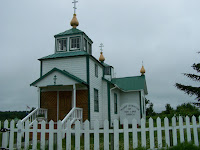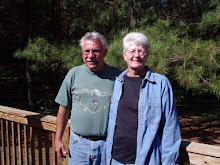Heading further south along the Sterling Highway, it took us 2 hours to drive 37.8 miles. As you can tell we are not into making a long day of it!

We passed through Anchor Point - population 1,814. Anchor Point was originally named "Laida" by Captain James Cook in the summer of
 1778, when the Resolution and Discovery sailed into Cook Inlet looking for the Northwest Passage. It was later renamed Anchor Point by early homesteaders to commemorate the loss of an anchor off the point by Captain Cook. This area is noted for its exc
1778, when the Resolution and Discovery sailed into Cook Inlet looking for the Northwest Passage. It was later renamed Anchor Point by early homesteaders to commemorate the loss of an anchor off the point by Captain Cook. This area is noted for its exc ellent seasonal king and silver salmon, steelhead and rainbow fishing opportunities. This is also an area where they use tractors to launch the boats. The road that goes into Anchor Point is the most westerly road that you can drive on in North America - as the sign here says.
ellent seasonal king and silver salmon, steelhead and rainbow fishing opportunities. This is also an area where they use tractors to launch the boats. The road that goes into Anchor Point is the most westerly road that you can drive on in North America - as the sign here says.Th
 ere is another Russian village - Nikolaevsk - population 297 - just 9 miles east of Anchor Point. This is a settlement of "Russian O
ere is another Russian village - Nikolaevsk - population 297 - just 9 miles east of Anchor Point. This is a settlement of "Russian O ld Believers" who arrived in the United States after the Bolshevik Revolution of 1917. The community included Russian Orthodox, Russian Old Believers (Old Right Believers) and some non-Russians, living in 3 distinct settlements. The Old Believers in this area lead a family-oriented, self-sufficient life-style. They use modern utilities, and food sources are from gardening, small livestock, fishing and hunting. Families are typically very large - 8 to 12 children. Traditional clothing is worn, Russian is the first language and the
ld Believers" who arrived in the United States after the Bolshevik Revolution of 1917. The community included Russian Orthodox, Russian Old Believers (Old Right Believers) and some non-Russians, living in 3 distinct settlements. The Old Believers in this area lead a family-oriented, self-sufficient life-style. They use modern utilities, and food sources are from gardening, small livestock, fishing and hunting. Families are typically very large - 8 to 12 children. Traditional clothing is worn, Russian is the first language and the  church dictates that males do not shave. Some of the houses were very ornate - Victorian in style - but most of them were small, and not very well taken care of. The exception were the farms we saw - they seemed to be neat and clean. Again a very interesting stop. The church wasn't open and the gate to the yard was closed so we only took pictures.
church dictates that males do not shave. Some of the houses were very ornate - Victorian in style - but most of them were small, and not very well taken care of. The exception were the farms we saw - they seemed to be neat and clean. Again a very interesting stop. The church wasn't open and the gate to the yard was closed so we only took pictures.We s
 topped at the Kachemak Bay rest area on a bluff overlooking the bay. Beautiful! Locals often say "Homer is where the land ends and the sea begins" and this viewpoint explains
topped at the Kachemak Bay rest area on a bluff overlooking the bay. Beautiful! Locals often say "Homer is where the land ends and the sea begins" and this viewpoint explains  this saying. There are expansive views of the Homer Spit and the highway as it descends Homer Hill. Once in Homer we passed several camping areas along the water but we wanted to find a place on the Spit. This is a huge sand bar that extends out into the Kachemak Bay by 4.4 miles. As we were driving along we spotted an immature Eagle sitting on buoy marker looking for dinner - a wonderful sight!
this saying. There are expansive views of the Homer Spit and the highway as it descends Homer Hill. Once in Homer we passed several camping areas along the water but we wanted to find a place on the Spit. This is a huge sand bar that extends out into the Kachemak Bay by 4.4 miles. As we were driving along we spotted an immature Eagle sitting on buoy marker looking for dinner - a wonderful sight!Homer has a population of 5,504 and was established on the north shore of Kachemak Bay at Homer Spit in 1895. Kachemak, the Russian name for the bay, means "high cliffs on the water." Another interpretation of the name suggests it means"smoky bay" and is derived from the smoke which once rose from the smoldering coal seams jutting from the clay bluffs of the upper north shore of Kachemak Bay and the cliffs near Anchor Point. In the early days many of the exposed coal seams were slowly burning from causes unknown. Today the erosion of these bluffs drops huge fragments of lignite and bituminous coal on the beaches, creating a plentiful supply of winter fuel for the residents. There are an estimated 400,000,000 tons of coal deposit in the immediate vicinity of Homer.
Jutting out for 4.4 miles from the Homer shore is the Homer Spit, a long, narrow bar of gravel. The road along the backbone of the Spit is part of the Sterling Highway, which is the main road through Homer. The Spit has had quite a history and it continues to be a center of activity for the town. In 1964, after the earthquake, the Spit sank 4 to 6 feet requiring several buildings to be moved to higher ground. Today Homer is the site of a major dock facility for boat loading, unloading and servicing and is a deep-water dock that can accommodate 340-foot vessels and 30 foot drafts, making it accessible to cruise and cargo ships.
The local part of Homer is not on the Spit - it is before the Spit begins. The Spit consists of mostly tourist places - shops and restaurants - and the fishing and boating activities. We camped on the Spit and enjoyed the view as it was looking westward across the bay at the Cook Inlet and the many volcanoes that line the inlet.
We didn't do much while we were there except do a lot of looking around and relaxing. We plan on coming back to Homer in a couple of weeks when our son Jason comes to visit - then we will do some of the more touristy things.









